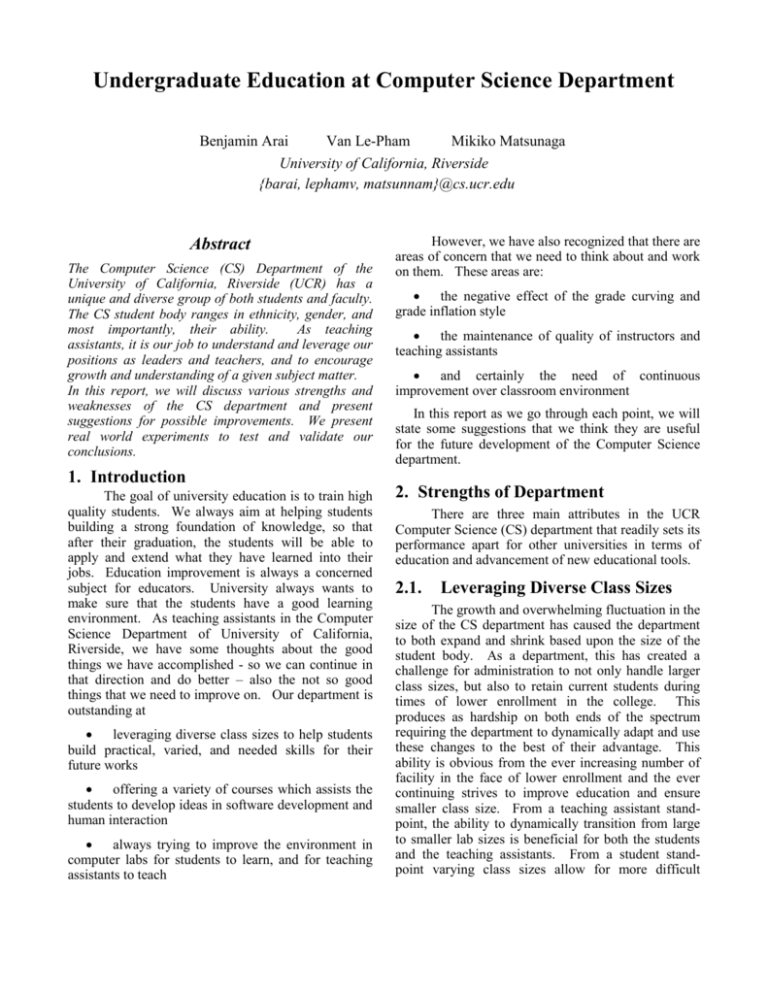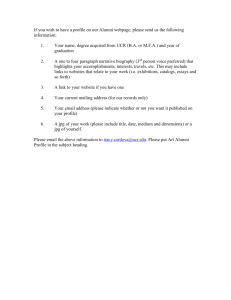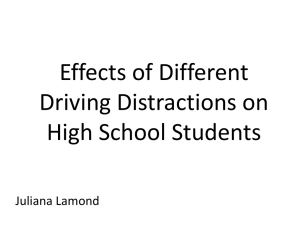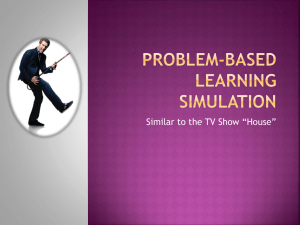Microsoft Document
advertisement

Undergraduate Education at Computer Science Department
Benjamin Arai
Van Le-Pham
Mikiko Matsunaga
University of California, Riverside
{barai, lephamv, matsunnam}@cs.ucr.edu
Abstract
The Computer Science (CS) Department of the
University of California, Riverside (UCR) has a
unique and diverse group of both students and faculty.
The CS student body ranges in ethnicity, gender, and
most importantly, their ability.
As teaching
assistants, it is our job to understand and leverage our
positions as leaders and teachers, and to encourage
growth and understanding of a given subject matter.
In this report, we will discuss various strengths and
weaknesses of the CS department and present
suggestions for possible improvements. We present
real world experiments to test and validate our
conclusions.
1. Introduction
The goal of university education is to train high
quality students. We always aim at helping students
building a strong foundation of knowledge, so that
after their graduation, the students will be able to
apply and extend what they have learned into their
jobs. Education improvement is always a concerned
subject for educators. University always wants to
make sure that the students have a good learning
environment. As teaching assistants in the Computer
Science Department of University of California,
Riverside, we have some thoughts about the good
things we have accomplished - so we can continue in
that direction and do better – also the not so good
things that we need to improve on. Our department is
outstanding at
leveraging diverse class sizes to help students
build practical, varied, and needed skills for their
future works
offering a variety of courses which assists the
students to develop ideas in software development and
human interaction
always trying to improve the environment in
computer labs for students to learn, and for teaching
assistants to teach
However, we have also recognized that there are
areas of concern that we need to think about and work
on them. These areas are:
the negative effect of the grade curving and
grade inflation style
the maintenance of quality of instructors and
teaching assistants
and certainly the need of continuous
improvement over classroom environment
In this report as we go through each point, we will
state some suggestions that we think they are useful
for the future development of the Computer Science
department.
2. Strengths of Department
There are three main attributes in the UCR
Computer Science (CS) department that readily sets its
performance apart for other universities in terms of
education and advancement of new educational tools.
2.1.
Leveraging Diverse Class Sizes
The growth and overwhelming fluctuation in the
size of the CS department has caused the department
to both expand and shrink based upon the size of the
student body. As a department, this has created a
challenge for administration to not only handle larger
class sizes, but also to retain current students during
times of lower enrollment in the college. This
produces as hardship on both ends of the spectrum
requiring the department to dynamically adapt and use
these changes to the best of their advantage. This
ability is obvious from the ever increasing number of
facility in the face of lower enrollment and the ever
continuing strives to improve education and ensure
smaller class size. From a teaching assistant standpoint, the ability to dynamically transition from large
to smaller lab sizes is beneficial for both the students
and the teaching assistants. From a student standpoint varying class sizes allow for more difficult
classes to be reduced in size while larger class sizes
are leverage for group projects and peer participation.
Both types of environment contain unique
aspects of education.
For larger class sizes it
encourages students to interact and perform in groups,
where many large companies strive to use group
models to development models such as XP (extreme
programming). On the other hand, smaller class sizes
provide a strong support and nurturing environment
for students. This type of model allows students who
require additional attention to obtain it will little or no
additional time. When these two types of
environments are leveraged properly such as in UCR,
we are able to not only address modifications to class
sizes, but also leverage the most ideal situations when
available. This also encourages a broad range of
education from both an intellectual as well as social
aspect.
2.2.
Development vs. Interaction
It has been a long standing tradition of computer
science and engineers to embrace the idea of hard
work in dark rooms. From this, they have been able
to build discipline and acute understanding of our
trade. This being said, computer science like many
other sciences have evolved into the not only a
technical skill but also a social one as well. Computer
science as we know it has stepped outside of the dark
rooms lit with computer tubes to become what we
think of today as true technical and social
professionals.
It is not acceptable to graduate
students who intend to program with no further
dreams. A computer science program must embrace
all walks of computer science from the technical
depths of C++ to the social interaction of client based
software development. With a complete skill set,
students can not only perform equal to the peer but
more importantly outperform the masses we strive to
climb above.
The CS department at UCR has embraced just
these qualities required to become a complete
computer scientist. This is evident from the continual
rigorous addition of new classes and seminars, and the
increase encouragement of social interaction through
the interaction of new classes such as software
engineering. With these additions, students are able
to form a concrete platform from which they can build
their technical understanding, and augment this
understanding by gaining the ability to interact and
advocated their ideas clearly and concisely.
In addition, the usage of XP programming
(group based development) is an emerging new trend
being used by various large institutions to increase
productivity and decrease errors bugs. UCR again
has jumped onto this new idea and introduced it into
the curriculum as requirement for current students.
Regardless, whether XP programming is beneficial or
not, the direct impact for student graduating and
moving into the work force is priceless because their
ability to understand and assimilate into different
development cultures is easier due to their broader
understanding of different development environments.
2.3.
Student Lab Environment
Student lab environment is a broad topic
ranging from student computers to the lab itself. In
all aspects the student lab in the UCR Computer
Science department has been a continual place of
improvement and changes, always pushing for better
environment for students to learn and teaching
assistants to teach. Combining these various aspects
of lab environment contribute to the overall
performance of undergraduate students in the UCR
computer science department.
From the lab perspective, the resource provided
in terms of computers and other computational
resources has been a source for continual improvement
ranging from continual migration to cutting edge
technologies to the standardization of Terminal
services technologies for lower division classes, to
standardized installations and create a manageable
environment for both users and administrators. One
of the most notable achievements of the CS
department is the interoperability of various operating
systems including Microsoft Windows, Mac OSX, and
other various distributions of Linux. Support for such
a large array of operating systems provides an ample
environment for students to experiment in various
environments and technologies. From a teaching
assistant stand-point the ability to use various tools
and applications gives a wide leveraging factor for
teaching assistants to illustrate different examples and
ideas.
Lab environment is also strongly effected by the
faculty and staff. Research has shown that the
arrangement of chairs and tables can be a determining
factor in helping students learn [1]. In the UCR CS
department, we have spent much time listening to
various faculty and staff regarding lab environment,
which has sparked changes to the current lab structure
including the addition of couches and chairs to provide
a more comfortable environment where students can
lounge around. This provides beneficial environment
for students providing a sense of comfort and care for
the labs. Distraction in a classroom has been a
continuous issue with a lot of labs and classrooms that
provides
internet
access.
Therefore,
other
improvements include the rearrangement of desks and
computers to create a better environment for students
to listen and become less distracted by other students
and computers.
certain level of fluency. Also, trainings specifically
aimed at conducting classes in computer labs may be
helpful as well, since it is quite unique compared to the
discussion sections for courses offered by the other
departments.
2.4.
3.2.
Summary
Some improvements which the department is
currently testing are methods for giving teaching
assistants control over all screens in a lab. This
allows the teaching assistant to remove distractions
from struggling students as well as possible broadcast
exampling information such as code that student
cannot see on the whiteboard. With the current
improvements already made and the current changes
as shown on the horizon is obvious the UCR computer
science department is not only well equipped but also
prepared for the future as emerge technologies become
available.
3. Weaknesses & Improvements
Despite the excellence of our department as
noted earlier, there are several areas in which we can
improve on. In this section, we will discuss various
departmental weaknesses in detail.
3.1.
Effective Education
The quality of education offered by the
department largely determines the quality of the
department. Because of its importance, care has to be
taken to maintain education at certain academic level.
The department should ensure that the educators meet
minimal qualifications as they are the primary provider
of the education.
The department should supplement training for
the non-native speakers. The instructors and TAs
should have certain level of fluency in English in order
to communicate with the students effectively. Even if
the instructor is acquainted with the material, students
will not be able to learn if the instructor cannot
communicate.
Currently, the Graduate Division
requires that all TAs whose first language is not
English to take an oral proficiency test and earn a
score of 40 out of 60 or above in order to work as a
TA.
Following the exam, the proficiency is
monitored by the evaluations from students submitted
at the end of each quarter [3]. However, the policy of
the Graduate Division does not clarify the
consequence of having unsatisfactory evaluation
results, nor does it mention if it will lead to dismissal
from the position. To supplement the requirements
and trainings offered by the Graduate Division, the
department can offer additional trainings to ensure
Student Quality
The department should put in more effort to
improve student quality. As in most universities,
UCR uses grade as the primary way to evaluate
students. For the grades to be meaningful, it should
reflect the level of understanding the students gained
from the course [1]. However, there is one significant
issue in the department that affects the validity of the
grades and the academic quality of students: the use of
grade curves.
Curving is a method used to adjust student
grades and is usually aimed at raising the average
score to a reasonable level. It is a common practice
and is observable in majority of the courses offered by
the department. However, despite the popularity,
many of its uses are inappropriate. For example, in
one of our classes offered here in UCR, a midterm was
given with allotted time of an hour. The exam was of
reasonable length and difficulty, as the students were
able to finish the exam on time and the average came
out to be about seventy percent, which corresponds to
an average letter grade of C. However, the exam was
curved in response to a single complaint from one
student who achieved a low grade on the exam. As a
result, the scores have boosted significantly, with a
student originally scoring seventy-five receiving a
ninety after the curve. Curving should only be used
in cases where justification exists, such as when a
three-hour exam is given in an hour-long class. Use
of curving on other occasions will result in grade
inflation, which triggers unwanted consequences.
Grade inflation lets students with inadequate
knowledge proceed to higher level courses. Upper
division classes have prerequisites to ensure that the
student has the necessary background prior to taking
the class. However, a student may have passed the
required course as a result of curving, not because the
student gained knowledge.
It may sound
unbelievable, but there are upper-division students
who have no idea what polymorphism is or have never
written more than a hundred lines of code. Such
students will suffer later for not being able to
understand the materials covered in advanced courses.
In addition, the reputation of the department will be
negatively impacted when these students get into
workforce with insufficient knowledge. Therefore,
inappropriate use of curves is also harmful to the
department.
In addition to when a curve is appropriate, how
a curve is applied needs to be considered as well.
Even if there is a justifiable reason to curve, the
method used can make the curve unacceptable. For
example, a curve should not be applied by simply
multiplying the scores by two. It did happen in one of
the classes, and the consequence was that the students
expected the same to happen for all of the following
exams. Many of them lost motivation to study,
because their effort will not be correctly reflected on
the grades. Again, curving leads to degradation of
student quality.
To address this issue, the department should ban
irrational curving. Any curving without a legitimate
reason should be prohibited. Currently, there is no set
standard on when a curve is appropriate and how the
curve should be performed. Because the department
only receives the final grades, there is no way to tell if
the grade is based purely on the graded material or if
some adjustments are made. To make the process
visible, one suggestion is to require scanned exams to
be turned in. It would be unrealistic to check all
exams from all of the classes, so pick few courses
randomly and check if the recorded grade matches
with the original grade assigned. Or, to simplify the
task, the history of changes can be stored by using
some kind of versioning system, such as Subversion,
to have the grade book versioned.
3.3.
Classroom Environment
Classroom environment plays an important role
in student’s learning. An environment consists of
everything inside the classroom, such as people, desks,
computers, and effective management of them is
necessary in establishing comfortable environment for
students to acquire knowledge.
One of the improvements that the department
can make is to minimize distractions caused by
students. Currently, the computer labs are used both
as a classroom and as an open lab, with no policy to
prohibit students from walking in to the labs while a
class is going on. As a result, outsiders can freely
enter the lab, take up a computer, and make noise.
Although the TA has the right to ask the outsider to
leave, it will take some time to walk up to the outsider
and ask for a leave, the time which can be used for
lecturing otherwise. Consistent interruption in the
midst of an explanation may confuse students and
disrupt concentration, negatively affecting their ability
to absorb the material. To resolve the problem, the
department can have a separate open lab for the
students to work on the assignments. Then, the labs
used for classes can be closed up, free from the
outsider intervention.
Unfortunately, outsiders are not the only cause
of distractions. In fact, students who belong to the
class can cause disruptions as well, usually in the
forms of having conversation with their peers. As the
large class size tends to make class management
harder, the department can support the instructor by
having small-sized classes. It also benefits the
student by giving them more individual attention than
with larger class.
Another areas in which the department can
improve is the computers in the labs. While the
computers are necessary for the students to work on
the assignments, they are not needed for them to take
notes. Indeed, having computers can even cause
distraction among the students by allowing them to
engage in chat rooms and play online games when
they are supposed to be listening to the lectures. As
in the outsider case, it also leads to the reduction of
concentration, so some action needs to be taken to
confront the problem.
There are several ways to approach the issue.
One approach is to have a separate room for the TA to
lecture. If the room does not have any computers,
then distractions from them cannot occur. Once the
lecture is over, then move back to the lab so the
students can work on the assignments. Although it
meets our need, the time it takes to move from one
room to the other may be significant, especially if the
rooms are far apart.
Another slightly more
sophisticated approach that is practiced in many
colleges and universities is to let the TA control all
monitors in the lab. The TAs can freeze all monitors
or shut down the computers in the lab if necessary,
preventing students from engaging in activities not
related to the class. Giving control not only reduces
distraction, but it also has positive side effects. For
example, allowing the TAs to transfer their screen to
student’s computers makes demonstrations to be
performed easily. It will solve the problem of using
projectors, where some students may not be able to see
the screen well. The only problem with this is that it
will take some time before such system becomes
available.
There is one simple approach that can be
performed immediately. The TAs can instruct the
students to turn off the monitor or bring the chair up to
the front until the lecture is over. This way, students
will not have the access to computers just as if the
computers are not present. The approach does not
take up invaluable class time and also does not require
Students vs. % Question's Correct
(Students attendance varied between classes)
100.00%
90.00%
% Correct Answers
any additional equipment. Although it does not have
the positive side effects as in controlling computers
approach, it suffices to serve as a temporary solution
to the problem.
The department should put effort into removing
possible cause of interruptions. In fact, one study
shows that often, about thirty percent of the class time
is lost due to interruptions [2]. Minimization of such
a significant cause of time loss will allow lectures to
be presented smoothly, enhancing the clarity and
understandability of the lecture.
80.00%
70.00%
60.00%
w/ Dist ract ions
50.00%
w/ o Dist ract ions
40.00%
30.00%
20.00%
10.00%
3.4.
Summary
In this section, we have explored possible areas
of improvement in detail.
We hope that the
department will put serious effort in facing the issues,
as it will lead to the betterment of the department and
as a consequence, to the betterment of the university as
a whole.
0.00%
St dt 1
St dt 3
St dt 4
St dt 5
St dt 6
Students
Figure 1: Effects of distractions vs. reduced distractions
in a lab/classroom environment
Class Standard Deviation w/ & w/o Distractions
(Students attendance varied between classes)
4. Experiment
1
0.9
0.8
Standard Deviation
After consideration, we decided to begin the
experiment in a lab environment. Our hypothesis is
that without the distractions (from computers as well
as from students) the students will understand the lab
material better. The number of subjects in our
experiment consists of students who attended their labs
on May 17th, 2005 and May 24th, 2005. Six students
attended May 17th lab, and three students attended
May 24th lab.
The small class size was chosen because our
research focuses upon upper division core courses.
We felt there will be too much distraction from other
class influences, and deviation in terms of curriculum
to provide meaningful results for lower division or
elective upper division courses. All of our results are
taken from CS152 for the spring quarter of 2005.
Distractions from computers and from students
were minimized for the May 24th class. To avoid
students from surfing the web or playing games, they
were not allowed to log on to their computer. In this
class, the lab was also left exclusively for students
who are currently enrolled in this lab. Other students
from other labs or classes were not permitted into the
lab. On the other hand, the students from the May
17th class did not need to change any of their habitual
class time. They were left to do what they have been
doing since the beginning of the quarter. For both of
the labs, the introduction of the lab assignment took
place at the beginning of the lab, and the quiz
consisting of questions related to the materials covered
in the lab was given afterwards.
St dt 2
0.7
0.6
0.5
w/ Dist ract ions
w/ o Dist ract ions
0.4
0.3
0.2
0.1
0
Figure 2: Effects of student distractions on deviation of
class performance
Our results show that as the distractions were
removed from the lab setting, not only do individual
student’s performance improve, the class as a whole
performed better as well. Overall improvement is
most likely improved due to the fact that as
distractions are removed from individual students, it
reduced distractions caused by a student affecting the
entire class. By removing these issues, we can
conclude that the removal of small distraction can in
fact benefit the entire class.
5. Results
The quiz which was given to both days’
students was graded in the scale of 10. As we
expected, the results have proved our hypothesis.
May 17th’s lab quiz scores distributed in a wide range,
from 3 to 8; and the average was 56.67%. The
standard deviation is at 0.18619.
In contrast, in the quiz taken on May 24th scored
a smaller range from 9 to 10, average score is 93.3%.
The standard deviation is at 0.057735.
The huge difference in the result may be
influenced by some factors as well. Since fewer
students attended the lab on May 24th, it may be that
out of the six students who attended the lab on May
17th, only those who had desire to listen came to the
lab. The possibility is supported by the facts that the
lab is offered early in the morning and that the lab
attendance is not part of the grade. Also, there may
be some difference in the difficulty of the quizzes.
Since the quizzes were written by a non-expert, the
questions on the May 17th quiz may be harder than the
May 24th quiz as it requires some practice to write
quizzes of consistent difficulty. Despite some biasing
of the result, the result still shows positive correlation
with our proposal.
6. Conclusion
In our research, we have found that by removing
any distraction from a lab environment is beneficial
for the students. Their quiz results have made a
tremendous difference in comparison with the class
that did not remove any distraction from the lab. The
distraction in a class environment is an obvious issue
in lab and classroom settings. Another observation is
that with the influence of one student cooperating with
the teaching assistants, it also influenced their peers in
the same class. The problems we were not able to
control are the class size of both classes. The results
will vary if the class size was bigger. Even with the
distraction level brought to the minimal in a class size
of up to 20 students, the number of students in the
class might add different type of distraction which the
teaching assistant cannot control. For example students
conversing between themselves while the teaching
assistant is teaching. In future research, it will be
interesting to see the same technique used in a
different department, for example, in the Physics or
Chemistry department. Would the distraction level
reduce to the minimal by removing necessary
distraction? These classes have one thing in common,
distraction from all dimensions. If most of these
distractions can be removed, would the students’ quiz
result show a difference as compared to our research?
There are many directions this research can head into
but for the purpose of our paper, we have found that
by removing necessary distraction does affect the
retention skills of the students.
7. References
[1] Burden, P. R. and Byrd, D. M. (1994). “Methods
for Effective Teaching”.
[2] Orlich, D. C. et al. (2001). “Teaching Strategies”.
[3] Teaching Assistant Handbook. (1996). Retrieved
May 20, 2005.
http://www.graddiv.ucr.edu/TheNextStep.pdf.
[4] http://www.usatoday.com/tech/news/2004-01-
20-blackboard-blues_x.htm
[5] http://www.ksu.edu/catl/discuss.htm





